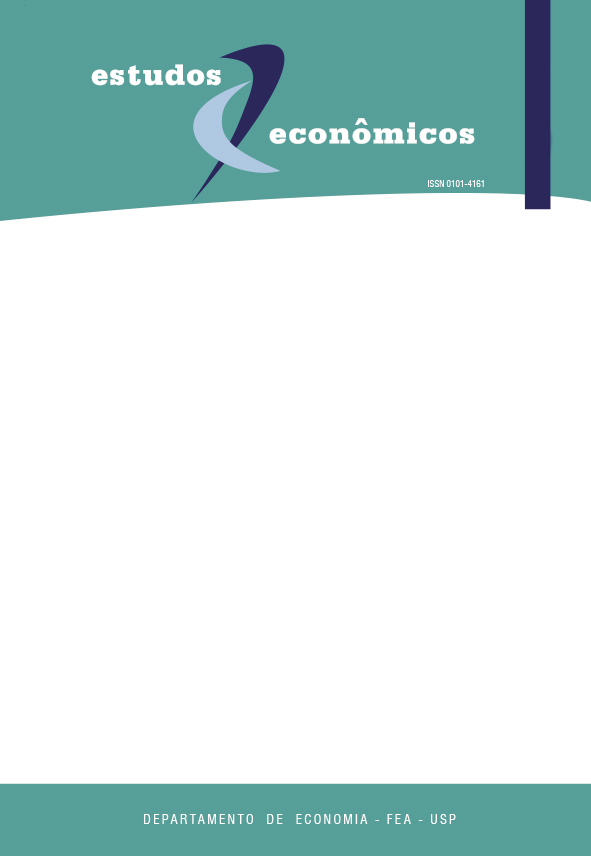Brazilian business cycles and growth from 1850 to 2000
DOI:
https://doi.org/10.1590/S0101-41612008000300005Keywords:
per capita GDP, business cycles, growth, BrazilAbstract
We study the cyclical and growth properties of Brazilian per capita output from 1850 to 2000. We find that, contrary to some developed countries, Brazil did not experience large changes in the volatility of per capita output. However, we obtained evidence that the oscillations in economic activity became more persistent after World War II.Downloads
References
ABREU, Marcelo P. O Brasil no século XX: a economia. In: IBGE (ed.). Estatísticas do século XX . Rio de Janeiro: IBGE, 2003.
BACKUS, David; KEHOE, Patrick. International evidence on the historical properties of business cycles. American Economic Review, v. 82, n. 4, p. 864-888, 1992.
BAER, Werner. A economia brasileira. São Paulo: Nobel, 1996.
BALDWIN, Richard; MARTIN, Phillipe; OTTAVIANO, Gianmarco. Global income divergence, trade and industrialization: the geography of growth take-offs. Working paper 6458. Cambridge: National Bureau of Economic Research, 1998.
BARRO, Robert J.; SALA-I-MARTIN, Xavier. Economic growth. New York: McGraw-Hill, 1995.
BLACK, Fischer. Business cycles and equilibrium. New York: Blackwell, 1987.
BURDEN, Richard; FAIRES, J. Douglas. Numerical analysis. Sixth edition. Pacific Grove: Brooks/Cole Publishing Company, 1997.
BURNS, Arthur F.; MITCHELL, Wesley C. Measuring business cycles. New York: National Bureau of Economic Research, 1946.
CABALLERO, Ricardo J. On the sign of the investment-uncertainty relationship. American Economic Review, v. 81, n. 1, p. 279-288, 1991.
CANOVA, Fabio. Does detrending matter for the determination of the reference cycle and the selection of turning points?. Economic Journal, v. 109, n. 452, p. 126-150, 1999.
CANOVA, Fabio. Detrending and turning points. European Economic Review, v. 38, n. 3-4, p. 614-623, 1994.
CAPORALE, Tony; McKIERNAN, Barbara. The Fischer Black hypothesis: some time-series evidence. Southern Economic Journal, v. 64, n. 3, p. 765-771, 1998.
CATI, Regina; GARCIA, Marcio; PERRON, Pierre. Unit roots in the presence of abrupt governmental interventions with an application to Brazilian data. Journal of Applied Econometrics, v. 14, n. 1, p. 27-56, 1999.
CHAUVET, Marcelle. The Brazilian business and growth cycles. Revista Brasileira de Economia, v. 56, n. 1, p. 75-106, 2002.
CONTADOR, Cláudio; HADDAD, Cláudio. Produto real, moeda e preços: a experiência brasileira no período 1861-1970. Revista Brasileira de Estatística, v. 36, n. 143, p. 407-440, 1975.
DUARTE, Angelo J. Mont’alverne; ISSLER, João Victor; SPACOV, Andrei. Indicadores coincidentes de atividade econômica e uma cronologia de recessões para o Brasil. Pesquisa e Planejamento Econômico, v. 34, n. 1, p. 1-37, 2004.
ELLERY Jr., Roberto; GOMES, Victor. Ciclo de negócios no Brasil durante o século XX: uma comparação com a evidência internacional. Economia, v. 6, n. 1, p. 45-66, 2005.
ELLERY Jr., Roberto; GOMES, Victor; SACHSIDA, Adolfo. Business cycle fluctuations in Brazil. Revista Brasileira de Economia, v. 56, n. 2, p. 269-308, 2002.
GOLDSMITH, Raymond. Brasil 1850-1984: desenvolvimento financeiro sob um século de inflação. São Paulo: Harper & Row do Brasil, 1986.
HADDAD, Cláudio. Crescimento do produto real no Brasil, 1900-1947. Rio de Janeiro: FGV, 1978.
HARDING, Don; PAGAN, Adrian. Dissecting the cycle: a methodological investigation. Journal of Monetary Economics, v. 49, p. 365-381, 2002.
HODRICK, Robert J.; PRESCOTT, Edward C. Postwar U.S. business cycles: an empirical investigation. Journal of Money, Credit and Banking, v. 29, n. 1, p. 1-16, 1997.
IBGE. Estatísticas históricas do Brasil: séries econômicas, demográficas e sociais de 1550 a 1988. 2nd edition. Rio de Janeiro: IBGE, 1990.
IBGE. Estatísticas do século XX . Rio de Janeiro: IBGE, 2003.
KALDOR, Nicholas. Capital accumulation and economic growth. In: LUTZ, Friedrich A.; HAGUE, Douglas C. (eds.). The theory of capital. Londres: Palgrave Macmillan, 1961.
LANNE, Markku; LÜTKEPHOL, Helmut; SAIKKONEN, Pentti. Comparison of unit root tests for time series with level shifts. Journal of Time Series Analysis, v. 23, n. 6, p. 667-685, 2002.
PERRON, Pierre. The Great Crash, the Oil Price Shock, and the unit root hypothesis. Econometrica, v. 57, n. 6, p. 1361-1401, 1989.
PINHEIRO, Armando C.; GIAMBIAGI, Fabio; GOSTKORZEWICZ, Joana. O desempenho macroeconômico do Brasil nos anos 90. In: GIAMBIAGI, Fabio; MOREIRA, Maurício M. (ed.). A economia brasileira nos anos 90. Rio de Janeiro: BNDES, 1999.
PRADO JR., Caio. História econômica do Brasil. 22nd edition. São Paulo: Editora Brasiliense, 1979.
RAVN, Morten O.; UHLIG, Harald. On adjusting the HP-filter for the frequency of observations. Discussion Paper 50. Tilburg: Center for Economic Research, Tilburg University, 1997.
SAIKKONEN, Pentti; LÜTKEPOHL, Helmut. Testing for a unit root in a time series with a level shift at unknown time. Econometric Theory, v. 18, n. 2 p. 343-364, 2002.
Downloads
Published
Issue
Section
License
Copyright (c) 2008 Eurilton Araújo, Luciane Carpena, Alexandre B. Cunha

This work is licensed under a Creative Commons Attribution-NonCommercial 4.0 International License.
By submitting an article, the author authorizes its publication and attests that it has not been submitted to any other journal. The original article is considered final. Articles selected for publication are proofread for grammatical and orthographic errors. The journal does not pay rights for published articles. The Institute of Economic Research from the School of Economics, Business and Accounting of the University of São Paulo (Instituto de Pesquisas Econômicas da Faculdade de Economia, Administração e Contabilidade da Universidade de São Paulo) owns the journal's copyright.





 Atualizado em 14/08/2025
Atualizado em 14/08/2025